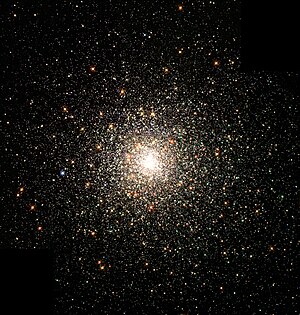
Back عنقود كروي Arabic Cúmulu globular AST Kürəvi ulduz topaları AZ Шаравое зорнае скопішча BE Кълбовиден звезден куп Bulgarian বর্তুলাকার স্তবক Bengali/Bangla Kuglasto zvjezdano jato BS Cúmul globular Catalan Kulová hvězdokupa Czech Kuglehob Danish

A globular cluster is a group of stars of a similar age which orbits the central bulge of a galaxy. Gravity holds clusters together and gives them their spherical shape. Towards the centre of such clusters, there are many stars in a relatively small space.
Globular clusters occur in the halo of a galaxy and in its disk. Those in the halo contain many more stars and are much older than the less dense open clusters in the disk. Globular clusters are fairly common: there are about 150 to 158 known globular clusters in the Milky Way.[2][3][4] Large galaxies can have more: Andromeda may have as many as 500.[5]
Some giant elliptical galaxies, particularly those at the centres of galaxy clusters, such as M87,[6] have as many as 10,000 globular clusters. These globular clusters orbit the galaxy out to huge distances, 40 kiloparsecs (approximately 131,000 light-years) or more.[7]
Every galaxy of sufficient mass in the Local Group has its group of globular clusters, and almost every large galaxy surveyed has a system of globular clusters.[8] The Sagittarius Dwarf and Canis Major Dwarf galaxies appear to be in the process of donating their associated globular clusters (such as Palomar 12) to the Milky Way.[9] This demonstrates how many of this galaxy's globular clusters might have been acquired in the past.
- ↑ "Hubble images a swarm of ancient stars". HubbleSite News Desk. Space Telescope Science Institute. 1999-07-01. Retrieved 2006-05-26.
{{cite news}}: Unknown parameter|authors=ignored (help) - ↑ Harris, William E. (February 2003). "Catalog of parameters for Milky Way globular clusters: the database". Retrieved 2009-12-23.
- ↑ Frommert, Hartmut (2007). "Milky Way globular clusters". SEDS. Archived from the original on 2006-01-18. Retrieved 2008-02-26.
- ↑ Ashman, Keith M.; Zepf, Stephen E. (1992). "The formation of globular clusters in merging and interacting galaxies". Astrophysical Journal, Part 1. 384: 50–61. Bibcode:1992ApJ...384...50A. doi:10.1086/170850.
{{cite journal}}: CS1 maint: multiple names: authors list (link) - ↑ Barmby P.; Huchra J.P. (2001). "M31 Globular clusters in the Hubble Space Telescope Archive: I. Cluster detection and completeness". The Astronomical Journal. 122 (5): 2458–2468. arXiv:astro-ph/0107401. Bibcode:2001AJ....122.2458B. doi:10.1086/323457. S2CID 117895577.
{{cite journal}}: CS1 maint: multiple names: authors list (link) [1] - ↑ McLaughlin, Dean E; Harris, William E. & Hanes, David A. (1994). "The spatial structure of the M87 globular cluster system". Astrophysical Journal. 422 (2): 486–507. Bibcode:1994ApJ...422..486M. doi:10.1086/173744.
{{cite journal}}: CS1 maint: multiple names: authors list (link) - ↑ Dauphole B.; et al. (1996). "The kinematics of globular clusters, apocentric distances and a halo metallicity gradient". Astronomy and Astrophysics. 313: 119–128. Bibcode:1996A&A...313..119D.
- ↑ Harris, William E. (1991). "Globular cluster systems in galaxies beyond the Local Group". Annual Review of Astronomy and Astrophysics. 29 (1): 543–579. Bibcode:1991ARA&A..29..543H. doi:10.1146/annurev.aa.29.090191.002551.
- ↑ Dinescu D.I; et al. (2000). "The absolute proper motion of Palomar 12: a case for tidal capture from the Sagittarius dwarf spheroidal galaxy". The Astronomical Journal. 120 (4): 1892–1905. arXiv:astro-ph/0006314. Bibcode:2000AJ....120.1892D. doi:10.1086/301552. S2CID 118898193.